Vollenhovia oblonga
| Vollenhovia oblonga | |
|---|---|

| |
| Scientific classification | |
| Kingdom: | Animalia |
| Phylum: | Arthropoda |
| Class: | Insecta |
| Order: | Hymenoptera |
| Family: | Formicidae |
| Subfamily: | Myrmicinae |
| Tribe: | Crematogastrini |
| Genus: | Vollenhovia |
| Species: | V. oblonga |
| Binomial name | |
| Vollenhovia oblonga (Smith, F., 1860) | |
| Subspecies | |
| |
| Synonyms | |
| |
Identification
Key
Indian Vollenhovia
- Mesosoma smooth and shiny, with a few delicate scattered punctures anteriorly; mandibles with 6 teeth; body length ≤ 2 mm . . . . . .Vollenhovia oblonga (subspecies laevithorax, larger size worker 3.75—4.0 mm)
- Mesosoma punctured; mandibles with 7 teeth; body length ≥ 2.5 mm Vollenhovia gastropunctata
Keys including this Species
Distribution
Latitudinal Distribution Pattern
Latitudinal Range: 6.893707° to -20.992°.
| North Temperate |
North Subtropical |
Tropical | South Subtropical |
South Temperate |
- Source: AntMaps
Distribution based on Regional Taxon Lists
Australasian Region: Australia.
Indo-Australian Region: Guam, Indonesia (type locality), Marshall Islands, Micronesia (Federated States of), New Guinea, Northern Mariana Islands, Palau, Solomon Islands, Vanuatu.
Oriental Region: India.
Distribution based on AntMaps
Distribution based on AntWeb specimens
Check data from AntWeb
Countries Occupied
| Number of countries occupied by this species based on AntWiki Regional Taxon Lists. In general, fewer countries occupied indicates a narrower range, while more countries indicates a more widespread species. |

|
Estimated Abundance
| Relative abundance based on number of AntMaps records per species (this species within the purple bar). Fewer records (to the left) indicates a less abundant/encountered species while more records (to the right) indicates more abundant/encountered species. |

|
Biology
Castes
Images from AntWeb
   
| |
| Worker. Specimen code casent0101274. Photographer Michele Esposito, uploaded by California Academy of Sciences. | Owned by MHNG, Geneva, Switzerland. |
   
| |
| Queen (alate/dealate). Specimen code casent0101601. Photographer April Nobile, uploaded by California Academy of Sciences. | Owned by MHNG, Geneva, Switzerland. |
   
| |
| Worker. Specimen code casent0102058. Photographer April Nobile, uploaded by California Academy of Sciences. | Owned by MSNG, Genoa, Italy. |
   
| |
| Worker. Specimen code casent0102059. Photographer April Nobile, uploaded by California Academy of Sciences. | Owned by MSNG, Genoa, Italy. |
    
| |
| Queen (alate/dealate). Specimen code casent0178419. Photographer Erin Prado, uploaded by California Academy of Sciences. | Owned by AMNH, New York, NY, USA. |
   
| |
| Worker. Specimen code casent0178420. Photographer Erin Prado, uploaded by California Academy of Sciences. | Owned by AMNH, New York, NY, USA. |
   
| |
| Worker. Specimen code casent0191433. Photographer Erin Prado, uploaded by California Academy of Sciences. | Owned by CAS, San Francisco, CA, USA. |
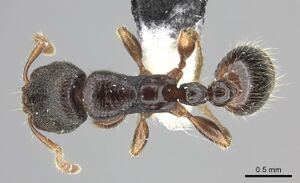  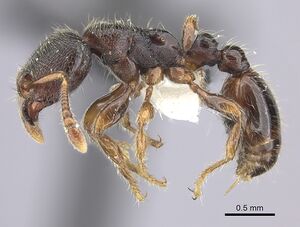 
| |
| Worker. Specimen code casent0199896. Photographer Will Ericson, uploaded by California Academy of Sciences. | Owned by EMSC, Eli M. Sarnat Collection. |
   
| |
| Worker. Specimen code casent0217982. Photographer Will Ericson, uploaded by California Academy of Sciences. | Owned by CAS, San Francisco, CA, USA. |
   
| |
| Syntype of Myrmica poneroides. Queen (alate/dealate). Specimen code casent0901008. Photographer Ryan Perry, uploaded by California Academy of Sciences. | Owned by NHMUK, London, UK. |
   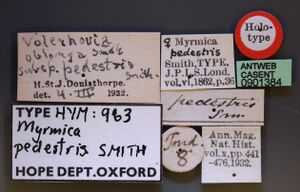
| |
| Holotype of Myrmica pedestris. Queen (alate/dealate). Specimen code casent0901384. Photographer Will Ericson, uploaded by California Academy of Sciences. | Owned by OUM, Oxford, UK. |
   
| |
| Syntype of Vollenhovia oblonga. Worker. Specimen code casent0901385. Photographer Will Ericson, uploaded by California Academy of Sciences. | Owned by OUM, Oxford, UK. |
   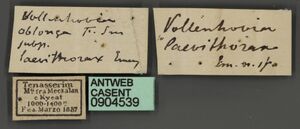
| |
| Syntype of Vollenhovia oblonga laevithorax. Worker. Specimen code casent0904539. Photographer Z. Lieberman, uploaded by California Academy of Sciences. | Owned by MSNG, Genoa, Italy. |
   
| |
| Syntype of Vollenhovia laevithorax rufescens. Worker. Specimen code casent0904540. Photographer Z. Lieberman, uploaded by California Academy of Sciences. | Owned by MSNG, Genoa, Italy. |
  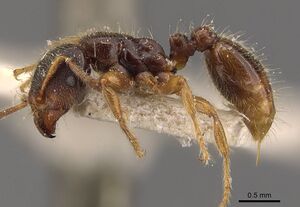 
| |
| Syntype of Vollenhovia oblonga dispar. Worker. Specimen code casent0908658. Photographer Will Ericson, uploaded by California Academy of Sciences. | Owned by MHNG, Geneva, Switzerland. |
   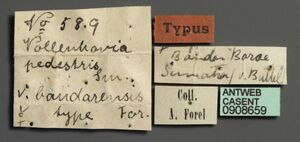
| |
| Syntype of Vollenhovia oblonga bandarensis. Worker. Specimen code casent0908659. Photographer Will Ericson, uploaded by California Academy of Sciences. | Owned by MHNG, Geneva, Switzerland. |
Nomenclature
The following information is derived from Barry Bolton's Online Catalogue of the Ants of the World.
- oblonga. Myrmica oblonga Smith, F. 1860b: 107 (w.) INDONESIA (Batjan I.). Wheeler, W.M. 1919e: 144 (q.). Combination in Vollenhovia: Emery, 1897d: 560. Senior synonym of poneroides: Emery, 1897d: 560; Donisthorpe, 1932c: 463. Current subspecies: nominal plus alluaudi, bandarensis, dispar, laevithorax, pedestris, rufescens.
- poneroides. Myrmica poneroides Smith, F. 1860b: 107 (q.) INDONESIA (Batjan I.). Combination in Vollenhovia: Mayr, 1886c: 361. Junior synonym of oblonga: Emery, 1897d: 560; Donisthorpe, 1932c: 463.
Type Material
- Myrmica oblonga Smith, 1860: Syntype, worker(s), Bacan (as Bachian), Indonesia, The Natural History Museum.
The following notes on F. Smith type specimens have been provided by Barry Bolton (details):
Myrmica oblonga
Two worker syntypes in Oxford University Museum of Natural History. Labelled “Bac.” (= Batjan I.). One specimen has the gaster missing.
Myrmica poneroides
Three queen syntypes in Oxford University Museum of Natural History (2 on one card, 1 on another), one queen syntype in The Natural History Museum. The Oxford University Museum of Natural History singleton labelled “Batchian.” (= Batjan I.), the others labelled “Bac.” Both Oxford University Museum of Natural History cards also have old labels, “Myrmica poneroides.”
Description
Unless otherwise noted the text for the remainder of this section is reported from the publication that includes the original description (Smith, 1860) page 107 as Myrmica oblonga.
Worker
Length - 1 ¾ line.
Obscure ferruginous, with the antennae, head anteriorly, mandibles, legs, and the apex of the abdomen, pale ferruginous. The head oblong and delicately striated; the eyes small and placed forward at the sides of the head. Thorax smooth and shining, with a few delicate scattered punctures anteriorly. Abdomen oblong-ovate, the apex pointed; thinly sprinkled with pale glittering hairs.
Hab. Bachian.
References
- Akbar, S. A., Bharti, H., Schifani, E., Wachkoo, A. A. 2023. Overview of the ant genus Vollenhovia (Hymenoptera, Formicidae) in India and Sri Lanka, with an illustrated key and the description of a new species. European Journal of Taxonomy 908, 77-107 (doi:10.5852/ejt.2023.908.2339).
- Bolton, B. 1995b. A new general catalogue of the ants of the world. Cambridge, Mass.: Harvard University Press, 504 pp. (page 423, catalogue)
- Donisthorpe, H. 1932c. On the identity of Smith's types of Formicidae (Hymenoptera) collected by Alfred Russell Wallace in the Malay Archipelago, with descriptions of two new species. Ann. Mag. Nat. Hist. 10(10): 441-476 (page 463, senior synonym of poneroides)
- Emery, C. 1897d. Viaggio di Lamberto Loria nella Papuasia orientale. XVIII. Formiche raccolte nella Nuova Guinea dal Dott. Lamberto Loria. [part]. Ann. Mus. Civ. Stor. Nat. 38[=(2(18): 546-576 (page 560, combination in Vollenhovia)
- Emery, C. 1897d. Viaggio di Lamberto Loria nella Papuasia orientale. XVIII. Formiche raccolte nella Nuova Guinea dal Dott. Lamberto Loria. [part]. Ann. Mus. Civ. Stor. Nat. 38[=(2(18): 546-576 (page 560, senior synonym of poneroides)
- Heterick, B.E., Kitching, R.L. 2022. The ants (Hymenoptera: Formicidae) of a one-hectare plot of lowland dipterocarp forest. Entomologist’s Monthly Magazine 158(4), 261–272 (doi:10.31184/m00138908.1584.4153).
- Smith, F. 1860b. Catalogue of hymenopterous insects collected by Mr. A. R. Wallace in the islands of Bachian, Kaisaa, Amboyna, Gilolo, and at Dory in New Guinea. J. Proc. Linn. Soc. Lond. Zool. 5(17b)(suppl. to vol. 4 4: 93-143 (page 107, worker described)
- Wheeler, W. M. 1919f. The ants of Borneo. Bulletin of the Museum of Comparative Zoology 63: 43-147 (page 144, queen described)
References based on Global Ant Biodiversity Informatics
- Bharti H. 2011. List of Indian ants (Hymenoptera: Formicidae). Halteres 3: 79-87.
- CSIRO Collection
- Chapman, J. W., and Capco, S. R. 1951. Check list of the ants (Hymenoptera: Formicidae) of Asia. Monogr. Inst. Sci. Technol. Manila 1: 1-327
- Clouse R. M. 2007. The ants of Micronesia (Hymenoptera: Formicidae). Micronesica. 39: 171-295.
- Clouse, R.M. 2007. The ants of Micronesia (Hymenoptera: Formicidae), Micronesica 39(2): 171-295.
- Field Museum Collection, Chicago, Illinois (C. Moreau)
- Janda M., G. D. Alpert, M. L. Borowiec, E. P. Economo, P. Klimes, E. Sarnat, and S. O. Shattuck. 2011. Cheklist of ants described and recorded from New Guinea and associated islands. Available on http://www.newguineants.org/. Accessed on 24th Feb. 2011.
- Lucky A., L. E. Alonso, E. Sarnat, and J. Hulr. 2015. Ants and scolytine beetles. In: Richards, S.J. and N. Whitmore (editors) 2015. A rapid biodiversity assessment of Papua New Guinea's Hindenburg Wall region. Wildlife Conservation Society Papua New Guinea Program. Goroka, PNG.
- Smith F. 1863. Catalogue of hymenopterous insects collected by Mr. A. R. Wallace in the islands of Mysol, Ceram, Waigiou, Bouru and Timor. Journal and Proceedings of the Linnean Society of London. Zoology 7: 6-48.
- Smith F. 1865. Descriptions of new species of hymenopterous insects from the islands of Sumatra, Sula, Gilolo, Salwatty, and New Guinea, collected by Mr. A. R. Wallace. Journal and Proceedings of the Linnean Society of London. Zoology 8: 61-94.
- Smith, Fr. "Catalogue of hymenopterous insects collected by Mr. A. R. Wallace in the Islands of Bachian, Kaisaa, Amboyna, Gilolo, and at Dory in New Guinea." Journal of the Proceedings of the Linnean Society of London, Zoology 5 (1860): 93-143.
- Taylor R. W. 1976. The ants of Rennell and Bellona Islands. Natural History of Rennell Island, British Solomon Islands 7: 73-90.
- Taylor R. W. 1987. A checklist of the ants of Australia, New Caledonia and New Zealand (Hymenoptera: Formicidae). CSIRO (Commonwealth Scientific and Industrial Research Organization) Division of Entomology Report 41: 1-92.
- Taylor R. W. 1991. Nomenclature and distribution of some Australasian ants of the Myrmicinae (Hymenoptera: Formicidae). Memoirs of the Queensland Museum 30: 599-614.
- Terayama M., and S. Haruhiko. 2005. Ants from Guam Island, Mariana islands, Micronesia. Ari 27: 1-5.
- Viehmeyer H. 1912. Ameisen aus Deutsch Neuguinea gesammelt von Dr. O. Schlaginhaufen. Nebst einem Verzeichnisse der papuanischen Arten. Abhandlungen und Berichte des Königlichen Zoologischen und Anthropologische-Ethnographischen Museums zu Dresden 14: 1-26.
- Wheeler W. M. 1919. The ants of Borneo. Bulletin of the Museum of Comparative Zoology 63:43-147.
- Wheeler, William Morton. 1927. The Ants of Lord Howe Island and Norfolk Island. Proceedings of the American Academy of Arts and Sciences 62(4): 121-153
- Wilson, Edward O. 1959. The Ants of Rennell and Bellona Islands. Nat. Hist. Rennell Isl. By Solomon Isl. 4:13-23.

